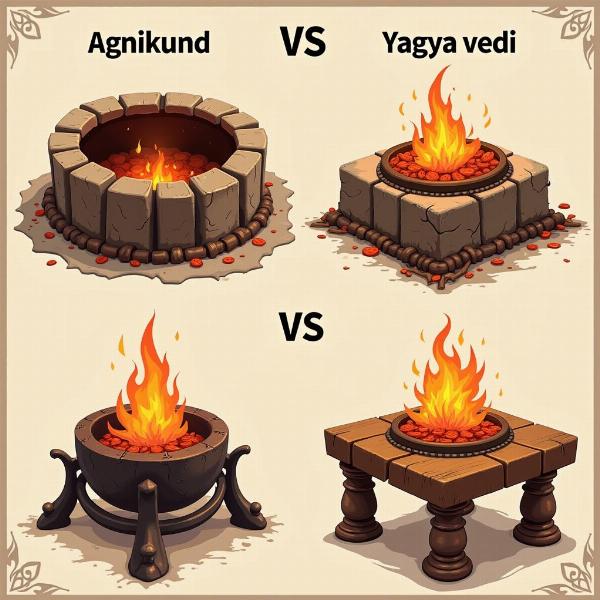Fire altars hold deep significance in Hindu culture and spirituality. Understanding the meaning of “fire altars” in Hindi, along with their symbolism and rituals, offers valuable insights into the heart of Hindu traditions. This guide explores the various aspects of fire altars, from their linguistic roots to their practical and spiritual applications.
Understanding “Fire Altar” in Hindi
The Hindi term for “fire altar” is commonly अग्निकुंड (agnikund) or यज्ञवेदी (yagya vedi). While both terms refer to a place where fire is kindled for sacred purposes, they have subtle differences. Agnikund generally refers to a pit dug in the ground and filled with fire, specifically used for havan or homa rituals. Yagya vedi, on the other hand, is a broader term that encompasses any platform or structure built for sacrificial fire ceremonies, including elaborate setups used in Vedic rituals.  Comparison of Agnikund and Yagya Vedi
Comparison of Agnikund and Yagya Vedi
Another term frequently encountered is वेदी (vedi), which simply means “altar” and can refer to both fire altars and platforms used for other offerings. Understanding these nuances helps us appreciate the rich vocabulary surrounding fire rituals in Hindi.
The Symbolism of Fire Altars
Fire, considered sacred in Hinduism, represents purity, knowledge, and divine energy. The fire altar acts as a conduit between the physical and spiritual realms, a focal point for offerings and prayers to reach the deities. The shape of the altar, often square or circular, holds symbolic meaning, representing stability and the cyclical nature of life, respectively.
Rituals and Practices Associated with Fire Altars
Fire altars play a central role in countless Hindu rituals, from daily prayers to elaborate ceremonies. Havan, a common ritual, involves offering grains, ghee, and herbs into the consecrated fire while chanting mantras. These offerings are believed to purify the surroundings, bring good fortune, and appease the deities. Larger scale yagyas involve intricate rituals and offerings performed by trained priests on elaborate yagya vedis.
What are the common offerings made on fire altars?
Common offerings include grains like rice and barley, ghee (clarified butter), herbs, fruits, and flowers. The specific offerings vary depending on the ritual and the deity being invoked.
Who can perform rituals on fire altars?
While simple havan rituals can be performed by householders, elaborate yagyas are typically conducted by trained priests who have specialized knowledge of the Vedic scriptures and rituals.
Fire Altars in Hindu Scriptures
The importance of fire altars is evident throughout Hindu scriptures. The Vedas, the oldest sacred texts of Hinduism, describe the construction and use of fire altars in great detail. These texts emphasize the precise measurements and materials used for building the altars, highlighting the significance of ritualistic precision.
Fire Altars in Modern Hinduism
While the grand Vedic yagyas are less common today, fire altars continue to be an integral part of Hindu religious practice. Many households maintain a small fire altar for daily prayers and occasional havans. Temples also feature fire altars where priests perform regular rituals.
Conclusion
Fire altars, known as agnikund or yagya vedi in Hindi, hold profound meaning in Hindu culture. They serve as a link between the earthly and divine, playing a crucial role in rituals and prayers. Understanding their symbolism and significance offers a deeper appreciation of the rich tapestry of Hindu traditions. The next time you encounter a fire altar, remember its significance as a sacred space where offerings and prayers ascend to the heavens.
FAQ
- What is the difference between agnikund and yagya vedi? Agnikund typically refers to a fire pit dug in the ground, while yagya vedi is a broader term for any platform used for sacrificial fire ceremonies.
- What is the symbolic meaning of fire in Hinduism? Fire symbolizes purity, knowledge, and divine energy.
- What are some common rituals performed on fire altars? Havan and yagya are common rituals involving offerings made into the consecrated fire.
- What are the common offerings made on fire altars? Grains, ghee, herbs, fruits, and flowers are common offerings.
- Where can I find fire altars? Fire altars can be found in homes, temples, and at locations where special ceremonies are performed.
- What are the benefits of performing havan? Havan is believed to purify the surroundings, bring good fortune, and appease the deities.
- Where can I learn more about fire altar rituals? Consulting with a Hindu priest or reading Hindu scriptures can provide more information.
Related Articles
Meaning-Hindi.in is your trusted partner for professional Hindi translation services. We offer a wide range of services, including business and commercial document translation, legal and certified translation, technical and user manual translation, website and localization translation, and educational and academic translation. We are experts in fast and specialized translation, catering to businesses and individuals. For accurate and culturally sensitive translations, contact Meaning-Hindi.in today! Email: [email protected], Phone: +91 11-4502-7584.